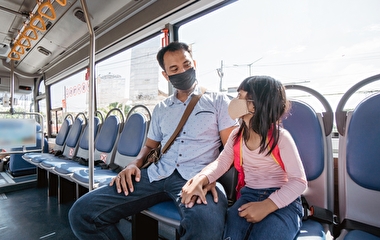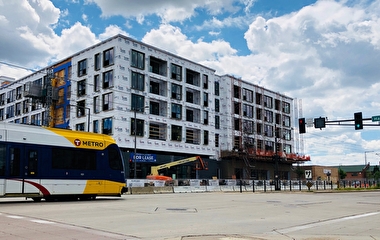Researchers and experts across the University of Minnesota system stepped up within a matter of weeks this spring to study COVID-19 and its impacts. Transportation-related projects—on topics such as contact tracing, pandemic transmission, and supply chains—are among the activities. Highlights follow.
Tracking outbreaks. Professor Shashi Shekhar (Computer Science and Engineering) and U-Spatial researchers are analyzing aggregate smartphone trajectory data to study the mobility impacts of COVID-19 policy interventions such as social distancing. In addition, Shekhar was part of the development team for the SafeDistance smartphone app. The free app, launched in April by the HealthPartners Institute, is intended to track COVID-19 outbreaks at the neighborhood level using crowd-sourced information from anonymous users. (See related story about Shekhar’s work.)
Transit and pandemic transmission. Alireza Khani (Civil, Environmental, and Geo- Engineering, CEGE) is continuing his studies of public transit and pandemic transmission, specifically of ways to meet core transit demand while maximizing rider safety through social distancing. “Ideally,” Khani says, “we want to estimate the origin-destination of transit-dependent riders and design service adjustments to serve these riders and ensure social distancing to minimize public health risk.”
Rural food logistics. Kathy Draeger (Extension Regional Sustainable Development Partnerships) is lending her experience to discussions of transportation logistics for the state’s food supply, particularly in rural and tribal areas. “There’s a lot of work connecting available food to food-insecure communities right now,” she says. These activities build on her pilot project that developed and tested “backhauling” as a way to help farmers get their produce to wholesalers for wider distribution (see story, January 2018 Catalyst).
Modeling the spread of the virus. Raphael Stern (CEGE) is working with a collaborator at Purdue University to model the spread of the virus. They are exploring how recent changes in the transportation network, such as canceled flights and travel restrictions, help control the spread. Stern is also interested in learning how the different stay-at-home orders and related policies have influenced travel within Minnesota.
Social distancing and adherence. Ingrid Schneider (Forest Resources) is conducting observational research of social distancing and adherence to COVID-related recommendations by nonmotorized transportation users. Collected on park trails in six states, the behavioral data will inform design, communications, and future planning. This novel longitudinal data set will also serve as a pilot for larger projects that integrate wearable technology and video data to more accurately assess physical distancing and health outcomes and better plan public spaces.
Medical supply chains. Lee Munnich (Humphrey School of Public Affairs) is studying medical supply chains as part of ongoing research in the Transportation Policy and Economic Competitiveness Program (TPEC).
Minnesota motorization trends. Also part of TPEC, Zhirong Zhao (Humphrey School) is expanding a periodical report on Minnesota motorization trends into one on Minnesota mobility trends and incorporating the impacts of COVID-19.
Telecommuting. Adeel Lari (Humphrey School) will explore whether telecommuting will become part of the “new normal” and what the impact will be on vehicle miles traveled and highway congestion. He also plans to study telecommuting’s geographical and equity implications. The work builds on research conducted under the eWorkplace program (see story, May 2019 Catalyst) and TPEC.
Social isolation. Carrie Henning-Smith (School of Public Health) and Yingling Fan (Humphrey School) are studying the role of transportation in addressing social isolation, with particular focus on older adults (see story, April 2020 Catalyst).
These and other researchers have also lent their expertise to state and national media. Visit the U of M website to learn more about the panoply of work under way.



